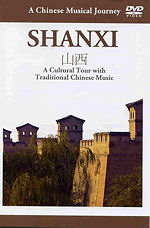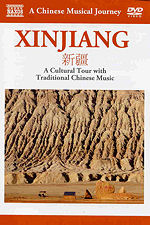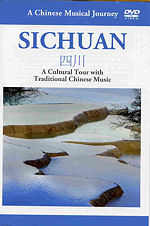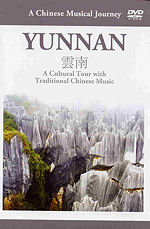| |
Naxos Travelogues - Cultural Tours of China - with
traditional music
A series of five Naxos DVDs visiting areas of China not normally visited
by foreigners, but popular tourist venues for the indigenous population
Picture format: NTSC 16:9. Sound format: Dolby Digital 2.0 and 5.1/DTS
5.1
Region code: 0 (worldwide). Booklet notes in English and Chinese
Faced with these five DVDs, I felt a little like the ancient visitor
to the orient who when offered the pleasures of the harem, looked
around, but scarcely knew where to begin. The cover pictures show
captivating scenery including an eroded mountainside, snow scenes
and an imposing city. One stood out, as I think it might for any casual
browser whose vision of China would certainly include the Great wall.
But this wall is not that of the renowned Great Wall, a World Heritage
site near Beijing the Chinese capital, but of the ancient walled city
of Pingyao, once a thriving commercial centre in Shanxi. So, rather
than following a geographical direction from the north, for example,
I started my coverage with this more central area and its captivating
walled town far to the west-south-west of Beijing.
As to general comments on this sequence of five DVDs, let me start
with the good news before the bad, both of which are found in all
of them. First, the photography is outstanding. Use an up-scaling
blu- ray player and the latest TV LED technology and the atmosphere
of the towns and the sheer spectacular nature of the scenery will
blow you away. The main problem is that in trying to read the notes
in the accompanying booklet, you will get lost as to exactly what
you are looking at: which lake; which temple? Oh for a few words on
the picture such as one gets with say an opera transmission with translation.
Another alternative would be the more extensive use of chapter/track
divisions rather than the derisory dozen or so, which is the practice
here. This latter limitation applies to all the Naxos Travelogues
I have seen. Even as I have watched DVDs in this series of places
in France or of Venice for example, that I know well, I have lost
the sequence when a scene or interesting place is shown that I do
not know and am dependant on sorting it from the notes.
As to this series on China, although I have made an extensive visit
to the country, even getting beyond the standard tourist trek, I have
never taken in any of these provinces with their diverse climates,
cultural backgrounds and magnificent scenery.
Also missing, and more obvious than in those covering European destinations,
where composers and orchestral structure is well known, are any descriptions
of the musical instruments being played. On a couple of occasions
the viewer can see what is being played, but from listening, and whilst
recognising regional differences on some occasions, it would have
been helpful to see the timpani, woodwind and strings being played.
Such a view is shown in CH.10 of Yunnan Province with ancient
Naxi music being played. I would have to be an expert in Chinese traditional
music to name the instruments, although some medieval music experts
might recognize similarities in some of the stringed instruments being
bowed or plucked with those that evolved in Europe. Unless I point
out particular differences in a Province, the accompanying traditional
Chinese music is much of a muchness and easily becomes aural wallpaper.
|

MDT
AmazonUK
AmazonUS

|
1. SHANXI
Naxos DVD
2.110556 [67.07]
The Province of Shanxi is situated west-south-west of Beijing.
The major centre of Taigan is 375Km from the capital with the ancient
walled city of Pingyao, the illustration on the cover that will catch
your eye being a further 450Km away. Pingyao is the best-preserved
ancient walled city in China (CH.1). It thrived during the Ming Dynasty
between 1368-1644 AD. The former wealth of the Province is illustrated
by the Courtyard Houses of wealthy families, all with extensive compounds
dating principally from the 18th century (CH.3).
Pingyao is world heritage site. To go alongside the walled city is
the spectacular Shuanglin Temple with its collection of 2,000 painted
statues from the Song and Yuan dynasties (CH.4). The nearby mountains,
many with religious connotations, are equally awesome as are the sacred
monasteries and other temples and pagodas galore (CHs.5-7). The most
remarkable of all is the Hanging Monastery at the foot of Mount Heng,
one of the Five Sacred Mountains of Taoism, apparently hanging on
a sheer cliff-face (CH.8). The carvings of the Yungang Grottos, some
51,000 statues of the Buddha in 252 caverns, dating originally from
the 5th and 6th centuries are equally impressive (CH.10).
The accompanying traditional Chinese music is little different from
others in the series. |

MDT
AmazonUK
AmazonUS

|
2. XINJIANG:
Naxos
DVD 2.110557 [59.49]
Located in the far north-west of China this autonomous region borders
Kazakstan, Kyrgystan and Mongolia. The ethnic mix is clearly represented
in the features of the local population and perhaps also influences
the music that is more heavily timpani dominated, with what sounds
like steel drums featuring heavily. The ethnic diversity is also reflected
in the living conditions and which feature Yurts and primitive log
cabins of the Kazakh and Mongolian inhabitants. The capital, Urumqi
is 30Km from the geographical centre of the continent of Asia with
its distinctive sculpture that looks like a giant plumb-line marking
the spot.
The physical geography is diverse as shown by the views of lakes,
plateaux with sheep, deserts with camels and fantastically eroded
rocks and glaciers, these natural features making a sharp contrast
with the largest wind farm in Asia. But, given the geographical position,
a surprise is the growing of grapes. Lush bunches of the white Turpan
grape are harvested and then hung out to dry. No explanation is given
as to why. Is it a variant of the noble rot developed in the autumn
in Bordeaux and which gives the divine and expensive renowned sweet
wines such as Barsac?
The wailing of the woodwind and the steely timpani are distinctive
musical sounds in the accompanying traditional music. |

MDT
AmazonUK
AmazonUS

|
3. SICHUAN
Naxos DVD
2.110558 [63.39]
The front picture tells a lot of the story of this region. Whilst
snow is a feature because of the mountainous terrain that protected
it from invasion for centuries, it shares the same latitude as Shanghai.
Bordering part of Tibet it is twice as far southwest from Beijing
as Shanxi. It is a land of lakes and snow-capped mountains,
with a fertile central plain. But the sub-tropics also have an influence
at this latitude with Qingcheng Mountain a mere 1300 metres high boasting
plum and palm tree-lined trails for the tourists on their way to the
holy Taoist mountain and its temples with carved, curved statues and
statuettes (CH.5).
Snow Mountain, the Oriental Alps, (CH.8) had a significant part to
play in China’s more recent history with the Red Army climbing over
it during The Long March of 1934-36 (CH.8). The region is also
famous for silk brocade (CH.10) and the water falls of Nuoriling,
the widest in the region, which freeze in winter. The Buddhist Mount
Emei, 130Km from Chengdu draws many indigenous tourists to see the
sunsets which are enjoyed here without the hassle of the hawkers and
the noise (CH.14). The accompanying music is perhaps more melodic
to western ears with woodwind and plucked strings dominant. |

MDT
AmazonUK
AmazonUS

|
4. YUNNAN
Naxos DVD
2.110560 [61.08]
A region of mountains and lakes, the province of Yunnan lies
to the south of Sichuan and in the far south-west of China.
It has borders with Burma (Myanmar) to the west, Laos
and Vietnam to its south whilst in the north-west it is contiguous
with Tibet. At 24 degrees south it shares latitude with Taiwan
and Japan. Its historic capital Kunming, has a population in excess
of five million and a history of two and one half thousand years.
(CH.4). With its history and distinctive minarets and towers Kunming
is the most popular tourist destination in the province. Bordering
Sichuan and Tibet the area of Shangri La in the
north west of the province is aptly named and has natural beauty and
tranquillity; its views live up to its name with precipitous impressive
scenery (CH.9).
The captivating picture on the front of the DVD needs just a little
study to discern what one is looking at. It is a Stone Forest produced
by the erosion of a form of limestone called Karst (CH.5). It is extremely
rare and was formed 270 million years ago, its stone teeth the consequence
of constant erosion by the monsoon climate which also accounts for
the caves, lakes and other unique geological features.
Yunnan is the home of the Naxi people and their music is distinct
in character. As I have noted above, it is one of the few occasions
that the viewer gets to see the instrumentalists of the various regions
covered in this series (CH.10). Put the scene on pause and get your
encyclopaedias out. |
|
5. TIBET
Naxos DVD 2.110559 [61.27]
Knowing something of the tortuous history and annexation of what
is described here as Tibet, Autonomous Region of China, I
at one time considered dealing with it as a separate entity from
the rest of the series. On reflection I decided that such a neo-political
statement was not appropriate to Musicweb International.
For once in this series, the view on the front of the DVD box fails
abysmally to do justice to what is shown. Thankfully the DVD itself
more than compensates. I am aware that I have littered superlatives
about the sites and situations illustrated in this collection. I
suggest you collect the superlatives all together and even then
they would not adequately describe what is shown in the opening
(CH1). It is the awesome view of the location and structure of the
Potala Palace located 2Km north-west of Lhasa the remote capital
of Tibet. The massive Palace has two distinct and easily recognisable
parts, the White Palace completed in 1645 and the Red Palace being
completed in 1694. The fifth Dalai Lama lived there.
The Lhasa River is one of five tributaries of the mighty Brahmaputra,
so important to the Buddhists. The music of recorder backing a very
high-pitched human voice is very distinctive (CH.2). The Jokhang
Temple (CH.3) dating from the 7th century, houses a revered image
of the Buddha. The music of a drone and timpani and periodic antiphonic
chants of the monks are particularly distinctive. The streets nearby
are shown later (CH.9).
Fifty kilometres to the north-east is the Ganden Monastery. It is
the seat of the Gelupga Buddhist order and holds important religious
relics (CH.7). The reputedly oldest building in Tibet, a place of
many legends concludes this tour. A tapering structure, its building
seems to sprout from a craggy ridge overlooking a patchwork of fields
(CH.10).
Tibetan music - the chanting of monks and other vocal and instrumental
pieces - is among the most distinctive and characterful in this
series.
Robert J Farr
|
|

